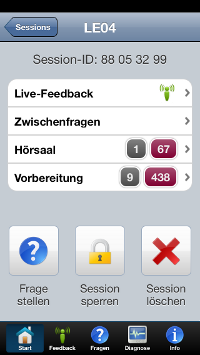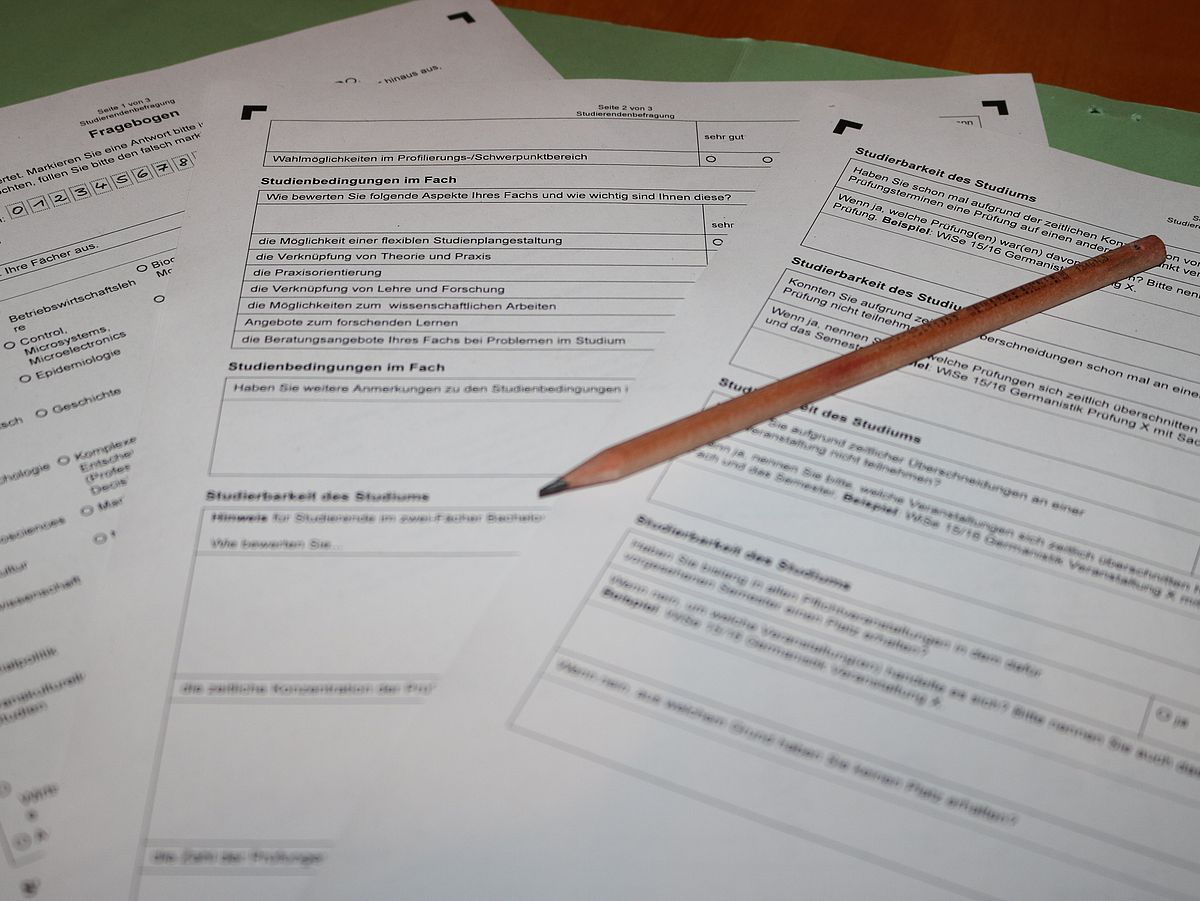Teaching evaluation
Different methods of teaching evaluation

On-line and paper-based course evaluations and other surveys can be carried out with the software Unizensus supplied by Blubbsoft GmbH. The software is linked to the learning platform Stud.IP via an interface and thus offers the advantages accruing from the joint data management of classes and lectures, teachers and students. All the Faculties and other institutions of the University of Bremen can use Unizensus free of charge. In this case, though, it is necessary to name and train the persons who will act as area administrators.
It is possible to develop your own question catalogs or use central specimen questionnaires. Evaluation of the survey can be carried out “at the push of a button”, and further data analyses are also available in the QM portal.
Christoph Wieselhuber (Administrative Department Teaching and Studies) offers support in working with Unizensus and conducts training courses for new area administrators. Work aids, such as the Unizensus manual, can be accessed in the QM portal.

The Stud.IP learning platform offers members of teaching faculty the opportunity to evaluate their own courses and lectures online. Evaluations with Stud.IP are particularly useful in cases where the Faculty does not conduct comprehensive evaluations or if individual members of the teaching staff have special requirements for their questionnaire. The service is available free of charge to all Faculties and instructors.
There are different forms of surveys in Stud.IP:
- Voting
- Questions with single or multiple choice answers
- Tests – similar to voting, but with a correct response and feedback on submission
- Evaluations – complex questionnaires with different types of questions (e.g. pole scales, multiple choice, free text)

Audience Response Systems (ARS) enable feedback to be obtained directly during or at the end of a course via smartphone or a clicker feedback, to present the evaluation directly via a projector, and to subsequently discuss the results with the participants. The advantage of direct, individual feedback in dialogical evaluations can thus be combined with the advantage of automated, static evaluation in standardized surveys. An example is the 5-minute teaching evaluation at the end of each lecture (after: Quidendey-Cirkel, K., 2015: Feedback. Arsnova.eu - Audience Response System for Innovative Teaching. Brochure of TH Mittelhessen) with the questions
- What have you learned today?
- What did you particularly like today? and
- What did you not understand and should be explained further in the learning platform?
On the pages of the ZMML you will find information on the use of ARS at the University of Bremen.
You can also contact the colleagues at ZMML by e-mail.
The brainstorming method is quick and easy to implement and enables immediate feedback from the course participants. To this end, the participants write down in a very limited time, possibly just a minute or two, everything that comes to their mind about a particular aspect of the course. It makes sense to consider a clearly delineated question and not to ask too generalist questions. In this way you may get only a snapshot of the mood, but this is relatively unadulterated. It is possible, though, to identify the trend. Brainstorming can also be done orally, but here the difficulty is that the answers relate to each other, and also the anonymity is not guaranteed.
In the case of impulse feedback, you provide a list of questions that students should complete. The questions should be easy to understand and can be answered by all students. Examples are:
- I was particularly interested in ...
- I was less interested ...
- I would rather have learned something (more) about ...
- I found it very important that ...
- I want to say that ...
- I was missing that ...
- Useful / important was that ...
- Less useful / important was that ...
- We progressed well / not well because ...
- I feel happy / I don’t feel happy because ...
- I did not agree when…
- In my opinion, the course should be changed in that ...
The answers are then evaluated by the teachers. By grouping, the general trend can be identified, but also extreme positions can be considered. Finally, the results of the course should be discussed together. This gives the teachers the opportunity to comment on the results.
With sufficiently large courses and under the condition that the teachers are not able to recognize students’ identity on the basis of their handwriting, the anonymity with this method is respected. Alternatively, the impulse feedback can also be done online, but it then usually loses its impulse character.

A target disk is divided into equally large segments. Each segment symbolizes a topic area to be evaluated (e.g. workload, selection of texts etc.). The target can be placed as a film on a daylight projector, hung as a large poster on the wall, or even drawn on the blackboard (in the latter case, photocopies should be made available. Every student (volunteer) can now draw points within the respective segments. The closer the point is set at the center, the more positive the evaluation is in the corresponding area. The rings should show the point scale (max. 5 rings). The feedback can be given both publicly (all students respond simultaneously) or anonymously (target is turned away from the group).
The instructor should in every case leave the room while the target fields are being completed.
The advantage of this method is that the result is made directly visible without much effort. Moreover, anonymity is preserved. However, the method is not suitable for groups that are too large (recommended for up to 30 people), since it otherwise becomes time-consuming.
Information on data protection
You can find the most important documents concerning data protection (unfortunately only in German) under:
- Process description for evaluation with Unizensus (Modul- und Lehrveranstaltungsevaluation mit der Software Unizensus – Verzeichnis von Verarbeitungstätigkeiten nach Art. 30 EU-DSGVO)
- Process description for evaluation with Stud.IP (Modul- und Lehrveranstaltungsevaluation mit StudIP – Verzeichnis von Verarbeitungstätigkeiten nach Art. 30 EU-DSGVO)
- Confidentiality declaration (Verschwiegenheitserklärung): All persons who have access to evaluation results as well as to data from the courses and module evaluation are obliged to sign a declaration of secrecy. According to the QM statutes, these are the Unizensus sub-area administrators, the deans, as well as those responsible for the degree program.
- Information sheet about the Confidentiality declaration
- Application for partial adminstraive rights for Unizensus and a corresponding evaluation account in Stud.IP (Antrag auf Teilbereichsadministrationsrechte für Unizensus und ein entsprechendes Evaluationskonto in Stud.IP)
- Datenschutzsatzung der Universität Bremen including Appendix 1 and Appendix 2
Further information is available in the QM-Portal.
General notes on teaching evaluation
Guaranteeing and maintaining anonymity is top priority in the evaluation process. This requirement is sometimes difficult to implement, especially in small classes. But there are also useful evaluation methods for small groups, (see above). Confidentiality applies to all parties involved: Students must be able to honestly express themselves without fear of consequences. Teachers also have the right to keep the results of an evaluation confidential. You will find basic information on data protection and how to handle the data connected with teaching evaluation at the top of this page and in the QM portal.
Evaluations can be carried out either at the end or after half or approximately three-quarters of the semester. In the end, it is possible to obtain an overall assessment, which can be particularly useful in the case of courses with a clearly defined qualification objective and whose content builds on preceding courses. The advantage of an earlier evaluation is that the results can be incorporated into the further course design and that the impression of the course is not influenced by a possibly imminent (or even an already) sat examination.
Evaluations should be separated from tests or examinations in order to avoid the impression that the evaluations may be somehow linked to the test results. This never happens and is indeed technically not possible.
The results of the evaluations should be fed back to the students, e.g. by posting the results or by discussion in class.
What follows from teaching evaluation
Evaluating seminars and lectures is just one way to obtain information on the quality of teaching. It is indispensable for the further development of content and didactical approach.
In the frame of the University of Bremen’s quality management system, it is recommended to make the results of evaluation known to the students. This is particularly desirable since it also has a positive effect on the willingness to participate. Students soon become “tired of evaluating” if they do not know what is happening with the results and whether any consequences are drawn from such surveys. It is recommended to discuss the results in the respective class/seminar. In this way, instructors also receive additional feedback, which may not have had a place in a questionnaire.
The results are also included in the quality report of the Faculty and can play a role in the context of accreditation (though only in an aggregated form).
If necessary, teachers should take the results of the teaching evaluation as an occasion to discuss matters with colleagues, confidants or the study dean in order to consder possible options for further education, training or coaching. There is a wide range of seminars on university didactics open to instructors at the University of Bremen.

Tips for creating questionnaires
Questionnaires should be kept as short as possible so that completion does not take too long. It is important to know which aspects you are really interested in, so that no data is collected for which you have no use.
As a rule, open questions bring interesting results; however, their evaluation is also highly complex. So be sparing with the open questions and take into account especially relevant aspects.
Only one aspect of the seminar/lecture can be evaluated per question; otherwise, participants who have different assessments of different aspects will find it difficult to provide a suitable answer.
There are a number of tried-and-tested catalogs for seminar evaluation, which have been critically reflected in the subject literature. In the case of such questionnaires, there is usually also the possibility to create indices (i.e. the combination of several items to a statistical value). Of course, the questionnaire forms can always be supplemented with input from instructors. Various specimen questionnaires are available in Unizensus.
